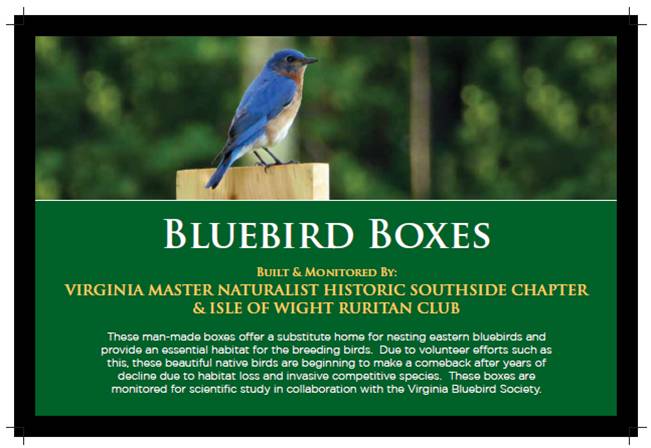Introduction
The Virginia Bluebird Society (VBS) was founded in 1996 to help increase the number of bluebirds and other native cavity nesters. Local volunteers monitor the bluebird boxes on a weekly basis from April through August each year in the park. They follow a VBS nest box monitoring protocol and record information each week to check on the progress and health of nests and nestlings, record observational data, watch for signs of vandalism, parasite infestation and/or predation, and send recorded data to state and national organizations. Boxes are inspected to record the following information: species, stage of nest construction, nesting materials used, number of eggs, estimated hatch date, number and estimated age of hatchlings, number of fledglings, estimated fledge date, and type of predation (if any).
Some facts to consider
Select the other buttons to learn more about protecting Bluebirds and their nesting habitats.
The Virginia Bluebird Society (VBS) was founded in 1996 to help increase the number of bluebirds and other native cavity nesters. Local volunteers monitor the bluebird boxes on a weekly basis from April through August each year in the park. They follow a VBS nest box monitoring protocol and record information each week to check on the progress and health of nests and nestlings, record observational data, watch for signs of vandalism, parasite infestation and/or predation, and send recorded data to state and national organizations. Boxes are inspected to record the following information: species, stage of nest construction, nesting materials used, number of eggs, estimated hatch date, number and estimated age of hatchlings, number of fledglings, estimated fledge date, and type of predation (if any).
Some facts to consider
- Males may carry nest material to the nest, but they do not participate in the actual building of the nest. They spend much time guarding their mates during the nest building time. The male and the female defend their territory. The males tend to defend territory edges while the females primarily defend the nest site.
- The Eastern Bluebird is also known as the American Bluebird, Wilson’s Bluebird, and the Common Bluebird. The Eastern Bluebird is among the three bluebirds that belong to the thrush family. The other two are the Mountain Bluebird and Western Bluebird.
- Adult bluebirds tend to return to the same breeding territory year after year. But young birds usually travel to some other location to live, rather than where they were born. Eastern Bluebirds from the southeastern U.S. may move short distances south in the winter, or simply remain on their breeding territories all year.
Select the other buttons to learn more about protecting Bluebirds and their nesting habitats.








